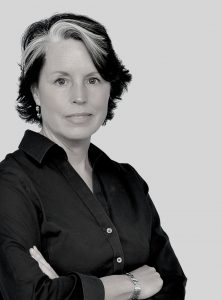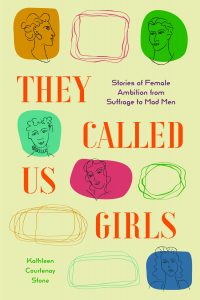Talking About Women’s History: Three Questions and an Answer with Kathleen C. Stone
When Kathleen Stone mentioned They Called Us Girls as the possible title for her upcoming book about women professionals in the mid-twentieth century to a group of us who are all writing biographies of women, the response was a unanimous “yes!”.
Kathleen studied art history in college, went to law school and now is a writer of nonfiction. As a lawyer, she was law clerk to a federal judge, litigation partner at a firm and senior counsel at a financial institution. She also taught seminars on American law in six foreign countries, including as a Fulbright Senior Specialist. Her writing has appeared in a variety of venues; more details are available on her website www.kathleencstone.com.
Since she was a young girl, Kathleen has been interested in boundary crossing women, and that led to her forthcoming book, They Called Us Girls: Stories of Female Ambition from Suffrage and Mad Men. A collective biography of seven women who pursued professional careers in an era when women were expected to stay home, it will be published by Cynren Press in the spring of 2022.
Take it away, Kathleen!
What works of women’s history have you read lately that you loved?
I’m excited to talk about three recent books. They’re all so good that I’m reading them simultaneously, or trying to.
First is Janice Nimura’s The Doctors Blackwell, which just came out in January. It’s about Elizabeth Blackwell, the first woman in the U.S. to graduate from medical school, and her sister Emily, also a doctor. The family of nine children was left in poverty when their father died. The sisters overcame the odds, including the fact that women were not permitted to attend medical school. Elizabeth graduated in 1849, Emily in 1854. Doctors at the time got very little training, almost none of it clinical, and many of the theories behind medicine were not just archaic but also deleterious to the patient. Yet they tried to bring a new approach to their patients.
I first heard about Elizabeth Blackwell while researching my own book. I’m writing a collective biography of seven women with professional careers, and two happen to be doctors. I wanted to understand how things were for women doctors in earlier generations, and that’s how I came across Elizabeth. Janice expands the lens to include Emily. Not only does she tell their stories but she also gives a vivid sense of the era in which they lived, for doctors and society in general.
At the same time, I’m reading Suzanne Koven’s Letter to a Young Female Physician. It won’t actually be published until May but I was lucky to get an advance copy. By including Suzanne’s book, which is more current than historical, I have to define “women’s history” broadly, but I really want to mention this book. Suzanne practices internal medicine at Mass General, and this is a memoir, with an emphasis on her professional life. She also shares advice about medical practice that is aimed particularly at women doctors.
Then there’s Perri Klass’s book, A Good Time to be Born. Perri is a pediatrician in New York who writes prolifically about both medical history and medicine today. Her book covers the advances in pediatric medicine that occurred from the mid-nineteenth century to today. The historical perspective makes it a great complement to The Doctors Blackwell. Even though doctors were mostly male throughout history, women were very involved with caring for sick children, as mothers and nursemaids. When I read the wrenching stories of desperately ill children, many of whom died, I reacted as a mother. This book, too, fits within my generous definition of the genre.
I don’t often read about medicine, and I don’t have much technical background, but each of these books is completely accessible. Together they give an unparalleled look at what life was like for women involved with medicine, and what it’s like today. I’m so glad to have the chance to talk about them.
How did you choose the women you write about in They Called Us Girls?
To answer this, I have to give a bit of back story. When I was young, my mother was a stay-at-home mom, and so were all the other women in our neighborhood. This was typical for the era, particularly in a suburban environment like mine. Cultural messages, conveyed by books, TV and other media, reinforced this as the norm. But I knew that a few women had gone to law school with my father. This intrigued me, even as a young girl, and I wanted to know what made them different from the women I knew.
I became a lawyer myself. After many years of practice, I realized I was still wondering about these other women of my mother’s generation. Not just lawyers, but women across a spectrum of professions. I decided to interview some and find out what made them venture outside the mainstream of cultural expectations. After a few interviews I realized my project would turn into a book. Now it has fully blossomed into a collective biography of seven women who had unusual professional ambitions in the mid-twentieth century.
When I started, I thought it was important to find women from a variety of fields. I also wanted diversity in race, ethnicity and socio-economic background, in order to see how formative experiences and influences were shared across groups.
I began with two women I knew personally but then, in order to branch out, I searched the internet. I also browsed public library shelves and read magazines. I contacted some of the women whose names I found. Although I was a stranger to them, coming completely out of the blue, a number agreed to be interviewed. But I couldn’t have pulled off this project without friends and acquaintances, especially women friends. They were full of enthusiasm for what I was doing and anxious to help with suggestions and introductions.
In the end, the women who appear in my book were found through a combination of my having clear criteria for what I wanted to accomplish, and being open to serendipity in making connections.
They Called Us Girls is such a great title! It encapsulates the experiences of several generations of women in the work place. Can you tell us how you came to it?
Thanks for your enthusiasm. The short answer to your question is – not easily. When I was sending out queries, I had a different title with which I wasn’t totally happy, but I had run out of ideas. After I found a publisher, she asked me to rethink the title. That led to more brainstorming and even crowd sourcing. My sister-in-law is a PR and marketing genius, and she went to her colleagues for ideas. Their suggestions helped shape my thinking about what I liked and why. Finally, it dawned on me that the title was within the book all along, hiding in plain sight.
One of the women I write about worked at OSS during World War II and later at CIA. Before she started her job with OSS, she had to pass a typing test. I asked her if men had to meet the same requirement and, of course, the answer was no. Typing was reserved for “girls,” which was the lingo of the day. I’ve written about another woman who now is a federal judge, but when she graduated from law school, she could not get a job with a law firm. Not only did firms not hire women but, she said, “they called us girls.”
Finally, I remembered my mother’s stories about working for IBM in the 1940s. Her title was “Systems Service Girl.” IBM’s website today refers to the position as “system service representative” but I remember clearly what she said.
Women doing a grown-up job but being called a “girl” was a through line of the mid-twentieth era. The word can be used in an affectionate, inclusive way, but that wasn’t what happened here. Even when it wasn’t intended maliciously, it reflected a culture where women’s abilities were diminished. For the most part, the women in the book overcame that negative thinking, but I wanted the title to remind us of their challenge.
Question for Pamela: Recently I heard you on a podcast, the Gal’s Guide to the Galaxy. You were talking about Maria Botchkareva, a Russian woman soldier during World War One. She was intrepid and fearless but ended up on the wrong side of history, meaning she was executed by the Bolsheviks for being an “enemy of the working class.” Clearly not a story where the woman ends up victorious. In the genre of women’s history, how effectively do writers today portray women as complicated beings who have flaws, make bad judgments and sometimes meet an unhappy end?
Back before women’s history was a recognized genre, there was a tradition of writing biographies of women to provide female role models for girls. Because those books were written for children, the rough edges were smoothed off. (Though part of what I loved about those biographies as a child was the fact that the women who accomplished things were never traditional good girls. They were Jo, not Meg; Laura, not Mary. )
Today I don’t know of anyone writing women’s history, for adults or children, who doesn’t at least try to address the complexity, the flaws, and the mistakes as well as the heroic aspects of individual women’s stories. Quite frankly, it’s more interesting.
Want to know more about Kathleen Stone and her work?
Visit her website: https://kathleencstone.com/
Follow her on Twitter: @KathleenCStone
Sign up for her newsletter:
* * *
Come back tomorrow for three questions and an answer with Anna MalaikaiTubbs, author of The Three Mothers.







Thank you for including Kathleen in your Q&A. I’ve learned much from her about writing and women’s writing in particular. We are fellow graduates of the Bennington Writing Seminars. This interview is fascinating both from a biographer’s point of view and from that of a baby-boomer, who was and still is a girl in so many people’s eyes.
I’m a fellow baby-boomer, and I definitely faced the “girl” issue more than once in my pre-writing career.